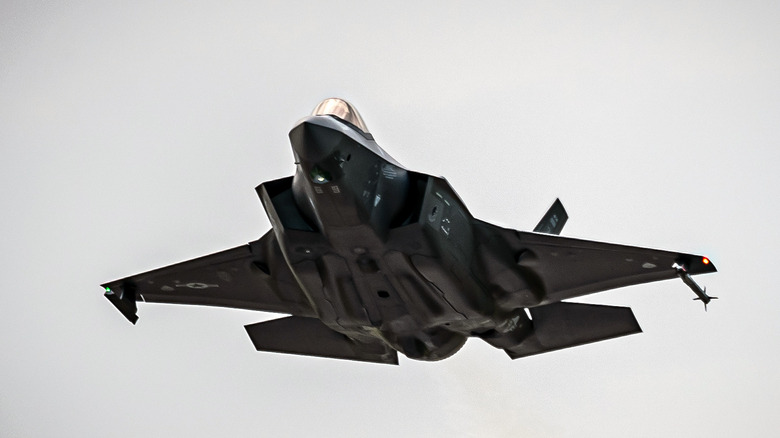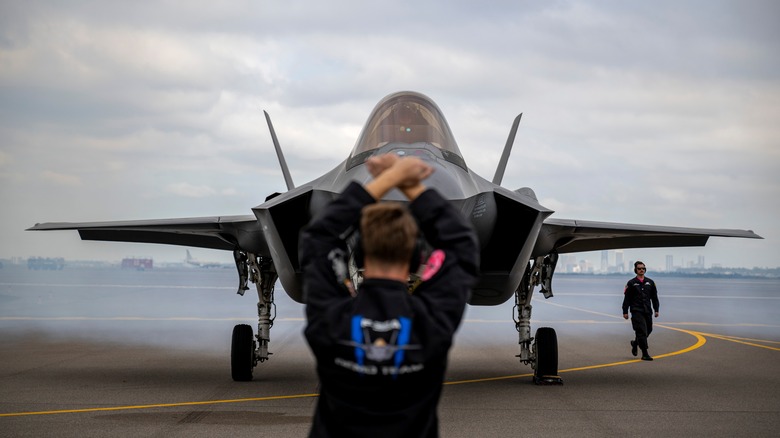The F-35 Could Get External Fuel Tanks - Here's What That Means
The United States wants to upgrade one of the most advanced jets ever built. Manufactured by Lockheed Martin, the F-35 Lightning II is a fifth-generation fighter lauded for its multi-functionality, serving not only as an advanced stealth fighter but also as the connective tissue between the military's air, land, sea, and space operations. Despite achieving success across nearly 630,000 sorties, the F-35 has been criticized for its lack of elite range, as its 670 nautical mile combat radius often forces pilots to rely on refueling to accomplish complex missions. Although there have been attempts to address the stealth fighters' range issues, any discussion of adding external tanks has been abandoned. However, internal opposition to these additions may be waning, as the U.S. Air Force's proposed 2026 budget states that the service is looking to "evaluate feasibility and decompose requirements for integration of External Fuel Tanks to support long-range missions of the F-35." This request is part of the $432 million effort to continue the Block 4 upgrades to the F-35 — a multi-year capabilities development program adding several hardware and software upgrades, ranging from electronic warfare suites to radar and arsenal improvements.
When Lockheed Martin discussed adding external tanks in 2019, experts estimated that they could increase the Lightning II's fuel capacity from 18,500 pounds to roughly 26,650 pounds – a much-needed upgrade as the prospect of long-range sorties through the Indo-Pacific becomes more strategically relevant. Typically located under the wings or fuselage, external fuel tanks come in one of two forms: conformal, or fuel reservoirs permanently attached to the plane, and drop tanks, which the aircraft can jettison after their usage. Unfortunately, external fuel tanks aren't a perfect solution, as they could complicate the fighter's stealth capabilities.
A complex debate
Adding external fuel tanks could serve as a highly feasible, ready-made solution to these issues. Lockheed Martin has studied adding underwing drop tanks to the stealth aircraft as far back as 2004, notably reexamining the concept as recently as 2019. Technologically, the addition could prove relatively straightforward, as the F-35's wings already sport the pylons for extra fuel tanks. Notably, Israel reportedly added external fuel tanks to its variant of the jet, the F-35I Adir. Although the specifics of these modifications largely remain a secret, experts credit the Adir's extended range with enabling the Israeli air force to strike targets deep within Iran without refueling. According to some observers, these fuel tanks potentially extended the F-35I's combat radius by up to 40%.
But the debate isn't whether they can add external fuel tanks, but whether they should. Adding external fuel tanks poses several aerodynamic challenges, potentially reducing the jet's speed and maneuverability. The greater concern, however, is that they degrade the F-35's stealth capabilities. To what degree this occurs will largely depend on the type of tank Lockheed Martin adds. Typically, modern conformal fuel tanks are designed to mitigate this effect. Drop tanks, on the other hand, provide more strategic flexibility but often come under fire for increasing an aircraft's radar cross section, even after they're jettisoned. While both are certainly feasible, the reported addition of ultra-stealthy drop tanks on the F-22 Raptor may hint at the future direction of the F-35. Another question is whether increasing the range of the F-35's arsenal is a lower-risk alternative.
Extending the F-35's future
Despite these challenges, failing to extend the F-35's range may pose an even greater risk to the jet's future, as relying on external refueling poses several stealth and security challenges. These concerns are poignant considering the delayed production schedule for Boeing's MQ Stingray – the stealthy unmanned tanker drone set to revolutionize the Pentagon's mid-air refueling operations.
As a new administration looks to leave its mark on the DoD, questions regarding the F-35's future have escalated. One reason is the F-35's status as the most expensive program aircraft in history, with the U.S. Government Accountability Office reporting in May 2024 that the program would exceed $2 trillion. Adding external fuel tanks may reduce these costs, as much of the F-35's price tag is because its limited range creates astronomical operating costs. According to a November 2024 Project on Government Oversight report, the F-35 needs to be 'forward deployed,' meaning it requires a wealth of infrastructure to transport the F-35 near its target to operate effectively. Exceedingly expensive, time-consuming, and logistically burdensome, the logistics surrounding its deployment are a major deterrent to the plane's availability. As such, the Air Force and the Navy have reduced the projected flight times of their F-35 fleets by 19 per cent and 45 per cent respectively.
By extending the range of the F-35, fuel tanks can make America's greatest stealth fighter less expensive and more flexible in its missions. Of course, range improvements constitute only a fraction of the additions Lockheed Martin plans to undertake in its upcoming 'Ferrari' upgrade to the jet. Born out of its failed bid to design the first sixth-generation fighter, awarded to Boeing's F-47, the manufacturer plans to bring a host of new capabilities to its prized fighter to cement its role in U.S. military operations.


